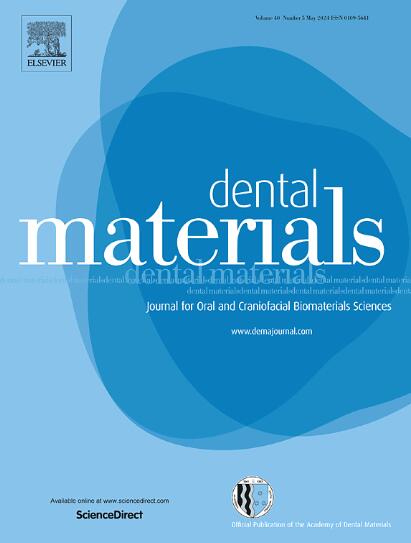牙科复合材料的直接墨水书写:向可持续椅旁生产的模式转变。
IF 4.6
1区 医学
Q1 DENTISTRY, ORAL SURGERY & MEDICINE
引用次数: 0
摘要
目的评估使用新型直接油墨书写(DIW)系统和临床认可的牙科复合材料打印的咬合贴面的尺寸精度:方法:根据基于挤出的 DIW 原理开发了一种新型三维打印机。该打印机主要由开源硬件构成,经校准后可使用流动树脂复合材料(Beautifil Flow Plus)进行打印。通过使用实验室共焦扫描仪对 20 个打印的咬合贴面的尺寸精度进行评估,对该技术的可行性进行了评估。精确度是通过将 20 个印刷品成对叠加来确定的,由此产生了一组 190 个偏差图,用于评估样本间的差异:结果:在没有材料浪费或残留的情况下, DIW 系统能在 20 分钟内打印出上颌臼齿的实心咬合贴面。在所有取样表面点上,未签名的整体尺寸偏差为 30.1 ± 20.2 µm(平均值 ± 标准偏差),中位数为 24.4 µm(四分位间范围为 22.5 µm),均方根值为 36.3 µm。成对叠加程序显示,样本间的平均尺寸偏差为 26.7 ± 4.5 µm(平均值 ± 标准偏差;n = 190 对),表明精度足够高。偏差与非挤压运动的可视化凸显了高偏差区域与材料串联之间的相关性:本研究强调了使用拟议的 DIW 系统制作间接修复体的潜力,该修复体使用的是临床认可的可流动树脂复合材料。未来的优化有望提高打印精度和打印速度。本文章由计算机程序翻译,如有差异,请以英文原文为准。
Direct ink writing with dental composites: A paradigm shift toward sustainable chair-side production
Objectives
To evaluate the dimensional accuracy of occlusal veneers printed using a novel direct ink writing (DIW) system and a clinically approved dental composite.
Methods
A novel three-dimensional printer was developed based on the extrusion-based DIW principle. The printer, constructed primarily with open-source hardware, was calibrated to print with a flowable resin composite (Beautifil Flow Plus). The feasibility of this technology was assessed through an evaluation of the dimensional accuracy of 20 printed occlusal veneers using a laboratory confocal scanner. The precision was determined by pairwise superimposition of the 20 prints, resulting in a set of 190 deviation maps used to evaluate between-sample variations.
Results
Without material waste or residuals, the DIW system can print a solid occlusal veneer of a maxillary molar within a 20-minute timeframe. Across all the sampled surface points, the overall unsigned dimensional deviation was 30.1 ± 20.2 µm (mean ± standard deviation), with a median of 24.4 µm (interquartile range of 22.5 µm) and a root mean square value of 36.3 µm. The pairwise superimposition procedure revealed a mean between-sample dimensional deviation of 26.7 ± 4.5 µm (mean ± standard deviation; n = 190 pairs), indicating adequate precision. Visualization of the deviation together with the nonextrusion movements highlights the correlation between high-deviation regions and material stringing.
Significance
This study underscores the potential of using the proposed DIW system to create indirect restorations utilizing clinically approved flowable resin composites. Future optimization holds promise for enhancing the printing accuracy and increasing the printing speed.
求助全文
通过发布文献求助,成功后即可免费获取论文全文。
去求助
来源期刊

Dental Materials
工程技术-材料科学:生物材料
CiteScore
9.80
自引率
10.00%
发文量
290
审稿时长
67 days
期刊介绍:
Dental Materials publishes original research, review articles, and short communications.
Academy of Dental Materials members click here to register for free access to Dental Materials online.
The principal aim of Dental Materials is to promote rapid communication of scientific information between academia, industry, and the dental practitioner. Original Manuscripts on clinical and laboratory research of basic and applied character which focus on the properties or performance of dental materials or the reaction of host tissues to materials are given priority publication. Other acceptable topics include application technology in clinical dentistry and dental laboratory technology.
Comprehensive reviews and editorial commentaries on pertinent subjects will be considered.
 求助内容:
求助内容: 应助结果提醒方式:
应助结果提醒方式:


